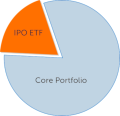We entered 2020 expecting an active IPO market from March to July, due to the depth of the pipeline and strong returns in the prior year. However, volatility from the coronavirus outbreak has now essentially shut down the spring IPO market. With admitted uncertainty, we expect a narrower IPO window in the summer, for companies relatively unaffected by the virus. More companies will tentatively target fall IPOs, including the seasonally-active months of September and October.
These are the three key hurdles shaping the 2020 IPO market:
Hurdle 1: Market volatility causes IPO activity to grind to a virtual halt (March – April)
It is nearly impossible to price most IPOs when volatility is near record highs. The Renaissance IPO Index dropped 9% on Monday, and the VIX Volatility Index reached its highest level since 2009. It has historically taken a few months for the IPO market to return to normal levels of issuance following volatility spikes of this magnitude. Any IPO will need to offer public investors extremely favorable discounts relative to public peers, if they can get done at all.
Hurdle 2: Virus hits 1H20 financials, dampening summer activity (May – July)
Assuming markets stabilize in a month or two, the second hurdle will come mid-year, when companies report how badly the coronavirus impacted their quarterly results, dampening summer activity. Companies try to go public when their outlook is brightest, with stronger recent quarters translating to higher demand. If investors are asked to buy an IPO coming off a weak quarter, again, they’ll demand sizable discounts.
Several IPOs on file have either cited the coronavirus risk specifically, or are exposed to heavily-impacted areas, including Atotech (delayed), Madewell, and Cole Haan. Companies with steep losses will have a particularly challenging path to IPO; if their growth evaporates, public investors have little reason to take the plunge. In addition to a variety of heavily-discounted deals, we may initially see a handful of SPACs, biotechs (e.g. Imara, Ayala, Lyra, Zentalis, ORIC), device companies (Pulmonx, Inari), defensive names (Albertsons), and "best-of-breed" or "quarantine-friendly" IPOs (ZoomInfo) attempt to test public markets.
Hurdle 3: The US presidential election (November – December)
Issuance typically slows down near the end of an election year. During the five election years since 1996, IPO activity in November and December averaged 11% of the annual total, compared to an average of 21% during non-election years. The current bottleneck may cause more companies to attempt to go public during the fall, and possibly cause an unusually active IPO market during election month.
The IPO investor's coronavirus play
The coronavirus has thrown a wrench in what would have been the most active period of the 2020 IPO market. In a period of high uncertainty, at least one thing is obvious: Going public in the past year was the smartest move a pre-IPO company could have made. And while that may be cold comfort to investors, the silver lining is that IPO buyers often see their greatest opportunities coming out of volatile periods, because even fundamentally strong companies will need to price attractively.
*This article was first published exclusively on IPO Pro.*


